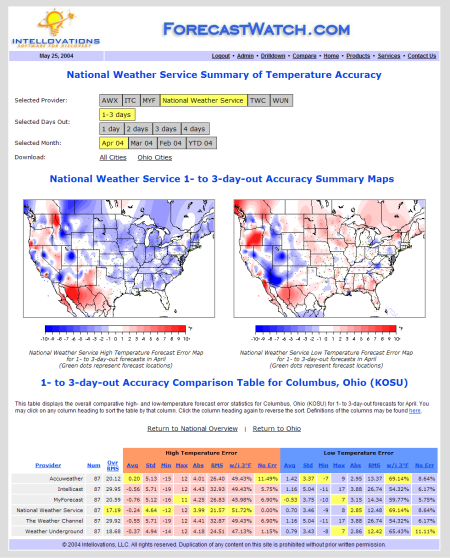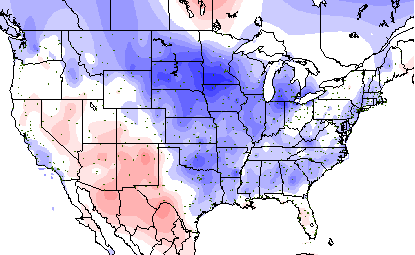ForecastWatch.com Uses Python To Help Meteorologists
| Category: | Software Development, Business, Scientific |
|---|---|
| Keywords: | Database, Data Mining, Web2.0, Knowledge Management, Quality, Scientific Programming, Weather |
| Title: | ForecastWatch.com Uses Python To Help Meteorologists |
| Authors: | Eric Floehr |
| Date: | 2004-05-26 |
| Website: | http://www.intellovations.com/ |
| Summary: | ForecastWatch.com uses Python to help meteorologists create more accurate weather forecasts. |
| Logo: | 
|
Introduction
ForecastWatch.com, a service of Intellovations, is in the business of rating the accuracy of weather reports from companies such as Accuweather, MyForecast.com, and The Weather Channel. Over 36,000 weather forecasts are collected every day for over 800 U.S. cities, and later compared with actual climatological data. These comparisons are used by meteorologists to improve their weather forecasts, and to compare their forecasts with others. They are also used by consumers to better understand the probable accuracy of a forecast.
The Architecture
ForecastWatch.com is built from four major architectural components: An input process for acquiring forecasts, an input process for acquiring measured climatological data, the data aggregation engine, and the web application framework.
There are two main input processes in the system: The forecast parser, and the actuals parser. The forecast parser is responsible for requesting forecasts from the web for each of the forecast providers ForecastWatch.com tracks. It parses the forecast from the page and inserts the forecast data into a database until it can be compared to the actual data. The actuals parser takes actual data from the National Climatic Data Center of the National Weather Service, which provides high, low, precipitation, and significant weather events for over 800 United States cities and inserts the data into the database. This process also scores the forecasts with the actual weather data, and places that information in the database.
Once the data has been collected and scored, it is processed by the aggregation engine, which combines the scores into yearly and monthly blocks, sliced by provider, location, and the number of days into the future for which the forecasts were predicting. In its first year, 2003, the system only gathered forecasts for 20 U.S. cities, or about 250,000 individual forecasts, so most of the data output was based on the raw scoring data. The aggregation engine was added once the system was scaled up to 800 cities, increasing the data stream by almost 4000%. In the first half of 2004, the system has already scored over 4 million forecasts, all collected, parsed, and displayed on the web.

ForecastWatch.com can be used to determine the accuracy of weather forecasts, for example by reviewing maps of error magnitude in forecast low and high temperatures Zoom in
The last component in ForecastWatch.com's architecture is the website itself. This is the interface through which customers access the collected and aggregated forecast accuracy information.
Implemented with Python
ForecastWatch.com is a 100% pure Python solution. Python is used in all its components, from the back-end to the front-end, including also the more performance-critical portions of the system.
Python was chosen initially because it comes with many standard libraries useful in collecting, parsing, and storing data from the web. Among those particularly useful in this application were the regular expression library, the thread library, the object serialization library, and gzip data compression library. Other libraries, such as an HTTP client capable of accepting cookies (ClientCookie), and an HTML table parser (ClientTable) were available as third party modules. These proved invaluable and were easy to use.
The threading library turned out to be very important in scaling ForecastWatch.com's coverage to over 800 cities. Grabbing web pages is a very I/O bound process, and requesting a single page at a time for roughly 5000 web pages a day would have been prohibitively time-consuming. Using Python's threading library, the web page retrieval loop simply calls thread.start_new() for each request, passing in the necessary class instance method that retrieves and processes the web page, along with the parameters necessary to describe the city for the desired forecast. The request classes use a Python built-in Event class instance to communicate with the main controlling thread when processing is complete. Python made this application of threading incredibly easy.
Python is also used in the aggregation engine, which runs as a separate process to combine forecast accuracy scores into monthly and yearly slices. The aggregation process uses queries via MySQLdb to the MySQL database where the input modules have placed the forecast and climatological data they have harvested. Colorized maps, showing forecast accuracy by geographical area, are then generated for use on the web site and in printed reports.

This forecast accuracy map uses intensity of blue and red to indicate the degree of error in predicting temperatures by geographical area
ForecastWatch.com's web interface was originally written in PHP but later changed to Python to simplify the toolset and improve integration with the other components of the system. Quixote, a Python web application framework, was selected as the basis for the entirely Python-based web front-end. The Quixote-based web application runs on Linux using Apache with mod_scgi, and was able to serve pages as fast as the PHP-based implementation. Python made it easier to make changes and add features than the PHP implementation. Quixote also provided for more flexible crafting of URLs, replacing PHP URLs like this one:
http://www.forecastwatch.com/drilldown.php?s=2&m=2&d=1&p=1&st=33
With easier to manage URLs like this:
http://www.forecastwatch.com/drilldown/awx/2004/02/1/AL
This is much nicer for the customer to bookmark or share with clients or potential clients. Finally, Quixote was easy to use and integrates well with Apache. For example, a redirect in Quixote is simply:
request.redirect(path-or-URL)
Python Made It Possible
Python played a significant role in the success of ForecastWatch.com. The product currently contains over 5,000 lines of Python, most of which are concerned with implementing the high-level functionality of the application, while most of the details are taken care of by Python's powerful standard libraries and the third party modules described above. Many more lines of code would have been needed working in, for example, Java or PHP. The integration capabilities of those languages are not as strong, and their threading support is harder to use.
Python is impressive as an object-oriented rapid application development language. One of Python's key strengths lies in its ability to produce results quickly without sacrificing maintainability of the resulting code. In ForecastWatch.com, Python was used for prototyping as well, and those prototypes were able to evolve cleanly into the production code without requiring a complete rewrite or switching toolsets. This saved substantial effort and made the development process more flexible and effective.
Because of the clean design of the language, refactoring the Python code was also much easier than in other languages; moving code around simply requires less effort.
Python's interpreted nature was also a benefit: Code ideas can easily be tested in the Python interactive shell, and lack of a compilation phase makes for a shorter edit/test cycle.
All of these factors combine to make Python a terrific alternative to C++ and Java as a general purpose programming language. ForecastWatch.com was made possible because of the ease of programming complex tasks in Python, and the rapid development that Python allows.
About the Author
Eric Floehr specializes in large-scale data collection & analysis, and consumer internet software, having worked with such companies as MCI, Datalytics, and Battelle. He holds a degree in Computer and Information Science from The Ohio State University. He has been in the technology industry for over 13 years, and is founder of Intellovations, LLC, a technology consulting company focused on building software for discovery -- challenging projects that bring new information and knowledge into businesses for competitive advantage, higher productivity, and greater profit. Intellovations has offices in Marysville, Ohio, and can be found on the web at http://www.intellovations.com.

